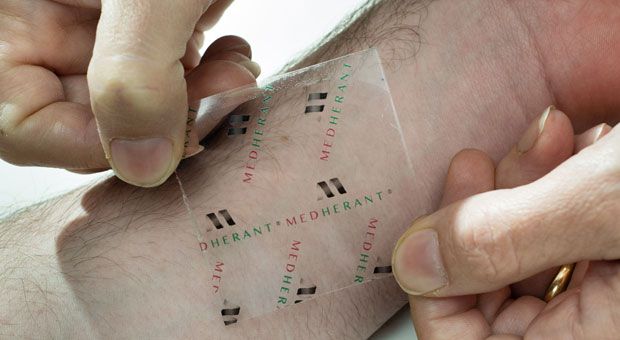Someday soon, treating aches and pains like a sore back or arthritis could be a lot easier—and more effective. Researchers at the University of Warwick in the United Kingdom have developed an adhesive ibuprofen skin patch that delivers a high dose of pain relief for up to 12 hours at a time.
RELATED: 9 Medications That Can Cause Heartburn
The British researchers said in a press release that the technology they've produced along with the bioadhesives company Medherant could change the way over-the-counter pain relief medications are sold. While medical patches and gels aren't new, Medherant says their technology offers improved effectiveness and design: The transparent, "highly tacky" patches stay in place on skin throughout the day, but are still easy to remove. They also deliver a higher (but consistent) dose of medication—five to 10 times that of similar products.
This could be big news for everyone, but especially chronic pain sufferers. Because the patch can be applied directly onto a pain source, it may be more effective than oral pills for combating pain in a specific area. It could also allow people who must regularly take high doses of ibuprofen painkillers to avoid potential side effects like an upset stomach, irregular heartbeat, or increased risk of heart attack and stroke.
RELATED: 27 Mistakes Healthy People Make
Medherant CEO Nigel Davis said that the ibuprofen patches will be hopefully available as over-the-counter products in about two years, adding that this new technology could potentially be used with a variety of medications in the future. "In addition to our pain relief products, our technology also works with drugs in many other therapeutic areas," he said. "We can see considerable opportunities in working with pharmaceutical companies to develop innovative products using our next generation transdermal drug-delivery platform.”
RELATED: 15 Natural Back Pain Remedies
"This patch technology is very exciting," says Houman Danesh, MD, director of Integrative Pain Management at The Mount Sinai Hospital in New York City. "When you apply the patch to an area locally, there's a lower risk of side effects like heart attack and stroke, because less of the medication is absorbed systemically."
There are a few similar patches out there, says Dr. Danesh, including a fentanyl patch, which is an opiate, a licodaine patch, which is a numbing medication, and a diclofenac patch, also called the Flector patch, which is for acute pain.
What's exciting about this patch is that it's see-through (while some other patches are white, for example), says Dr. Danesh, and "it seems like the technology is a stronger adhesive that will stay put on the area you apply it for longer without leaving any residue," he says. "The major challenge is if insurance companies will cover the cost of the medication."
